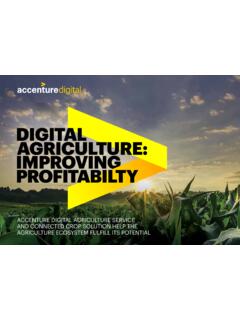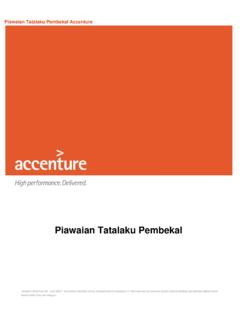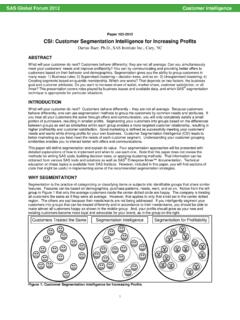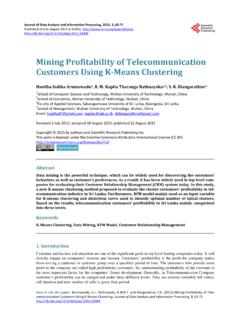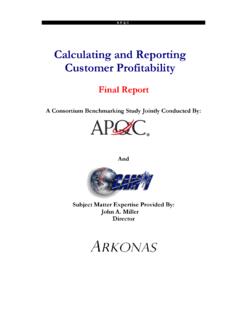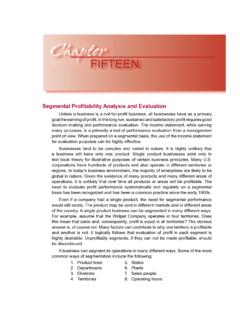Transcription of Five Customer-Focused Steps to Increase Profitability in ...
1 Five Customer-Focused Steps to Increase Profitability in the Steel Industry2 Steel producers have experienced tough times in the past few years. The market has suffered from persistent weak demand amid increasing volatility. China s exports as well as those from other emerging market producers are further changing the competitive and in the past, many steelmakers have shied away from making fundamental improvements to their sales approach and from efforts to Increase operational flexibility, despite the volatile market. Instead, they have favored short-term fixes such as tactical cost cutting, asset restructuring and incremental optimization. Sales were seen as a necessary evil to fill the mill and not a function to be improved. To Increase competitiveness, steel producers need a fundamental paradigm shift that puts a priority on improving sales and find out what changes are needed, accenture examined the performance of major steelmakers globally.
2 We identified five game-changing Steps taken by companies in the lead. These companies:Identify customer requirements under consideration of process volatility1 Understand the Profitability range of products and services to reduce complexity2 3 Segment customers based on service requirements and profitability3 Transform supply chains into highly reliable and agile ecosystems4 Adapt personnel, procedural and informational skills to facilitate the new approach5 4 Market situationAs it continues to face sluggish demand, the global steel market has been changing from a sellers to a buyers market. Capacity and production volumes have grown faster than global demand since the economic crisis of 2009. 0 US$/t200 US$/t400 US$/t600 US$/t800 US$/t1000 US$/t0%20%40%60%80%100%Ut ilizationUS Domest ic Hot Ro lle d Coil ( HRC) Avera ge Pri ces2002200320042005200620072008200920102 0112012201320142015 Figure 1.
3 Global steel capacity continues to grow despite increasing challenges in the : Steel Business Briefing, 2016 The consequences are rising overcapacity and declining utilization while volatility remains high (see Figure 1). The seriousness of this crisis is further intensified by growing Chinese exports without ease in the same time, prices linger at a low level, and steel users have begun to substitute competitive products like aluminum or plastic components. Prices have also been impacted by pressure from automotive suppliers and original equipment manufacturers (OEMs) that have merged into buying powerhouses. Supported by sinking transportation costs and improving logistics capabilities, steel is now produced almost anywhere in the world and shipped at reasonable prices with reduced effort. In Europe, North America and many other markets, the Increase in exports from China is putting further stress on prices.
4 With a total import volume of 95 million tons in 2014, for instance, Chinese imports in Europe were almost at the same level as total production from European steelmakers approximately 100 million tons per Wocher, Martin. EU wehrt sich gegen Stahl-Dumping, Handelsblatt, 13 May complication and traditional reactionHistorically, steelmakers have reacted with temporary price decreases and short-term cost reductions. This has taken a toll on profits for many producers in industrialized countries. In the current situation, problems are hitting these mature markets all at once and producers are focused on establishing trade restrictions that are of no long-term addition, steelmakers in developed markets can no longer leverage product quality as a major competitive differentiator since quality of commodity steel from emerging countries is constantly improving. Considering this trend, it is critical to focus on the right service research shows that quick fixes are no longer effective.
5 What may have worked in the past accommodating cyclical market fluctuations with a short-term focus is no longer sufficient because of the permanently altered market practices for customer focusA long-term measure that will help improve Profitability and reduce volatility is to align steel production with customer needs. The steelmakers that pursue this strategy will have a key differentiator in this new buyers market. The approach of focusing on customer requirements is not new; however, to do it correctly, companies must go through a fundamental paradigm change. They must leave behind fill the mill thinking and begin to see themselves as companies that deliver as promised to the needs of the first step is for steelmakers to understand that customer centricity is key to success. Uncertainty can be reduced by including customer needs into the strategic , what the customer needs is both a particular technical specification as well as production and delivery flexibility.
6 Delivering this enhanced value proposition for customers through a highly dynamic, flexible and agile supply and production chain can, therefore, become a competitive advantage. This may mean making significant changes to production and delivery operations. In some cases, it will also mean improving inventory management so that capacity will be available on short notice when needed. In time, we believe successful steelmakers may even profit from ongoing volatility by preparing and adapting their supply chains so they can seize opportunities as they arise. In other cases, companies may need more targeted sales-related or research and development (R&D) services to differentiate changes will influence the culture and long-term strategy of many steelmakers. It requires company-wide adaption of personnel, procedural and informational skills. All steelmakers are impacted by these developments, but those in North America and Europe will be impacted the most given the market situation.
7 It is critical for these steelmakers to act , accenture proposes five elements for steelmakers to help master the paradigm change, improve commercial excellence and become leading producers. Steelmakers should:1. Identify customer requirements under consideration of process Understand the Profitability range of products and services to reduce Segment customers based on service requirements and Transform supply chains into highly reliable and agile Adapt personnel, procedural and informational skills to facilitate the new customer requirements under consideration of process volatility7 Steelmakers can better understand customers plans by striving to understand their needs and communicating in a way that addresses those needs. For instance, if customers desire price certainty, producers can seek to offer it, rooted in a deep understanding of the steelmaker s own costs throughout the internal supply has worked with many companies in the resources industries to explore both the obvious and obscure needs of the customer .
8 We link those needs with the customers willingness to pay for customization and related services. We also help our clients change their sales approach and organization to hone in on this area of a recent steel industry analysis, for example, accenture collaborated with a client to jointly define and agree on their customers key buying criteria and how those related to basic factors, such as delivery reliability or product quality standards. After determining this, the team interviewed customers and developed an ideal offering that was linked to the customers willingness to pay. As a final step, accenture developed pricing options for various services and products for the focus on customer needs will further improve the understanding of buying patterns in the steel value chain overall. Steelmakers can anticipate changes in demand based on early warning signs, allowing these producers to gain a short-term competitive advantage by adapting their own market behavior before their competitors can do so.
9 Steelmakers can do this in addition to covering the basic factors and striving for delivery as the Profitability range of products and services to reduce complexity910 Most steel producers have a supply and production chain that ranges from ironmaking to semi-finished and finished products. The diversity in steel grades, dimensions, production paths, mechanical properties, tolerances and surface treatments increases complexity in production planning and execution. Unplanned downtimes, production breakdowns or changes introduced by the customer make production-as-planned an extraordinary challenge. It becomes even more complicated when steelmakers try to adjust production based on poor data or, in some cases, no data at inferior or missing data, steelmakers exert a great deal of effort in an ad-hoc manner, as they try to make the supply and production chain more efficient (often attempting this manually).
10 This threatens delivery performance and customer satisfaction, and it also leads to lower transparency about the real costs of production, lead times and ultimately customer /order this, it is critical to reduce complexity in the supply and production chain in order to become and stay profitable and to deliver as promised. One way to manage this is to analyze the portfolio and identify product priorities, while at the same time offering limited product customization based on the customer s willingness to pay. This is a difficult balance to , providing a wide, unprioritized range of products may seem to be in the interest of both the customer and the steelmaker. But even if a wider range of products targets more customers and might be helpful for increasing the utilization of production facilities, a lack of prioritization will eventually endanger delivery performance and, with it, the customers willingness to pay prices for products and services that are profitable for the , accenture recommends a strong customer focus that results in limiting and prioritizing product offerings for customer segments.



